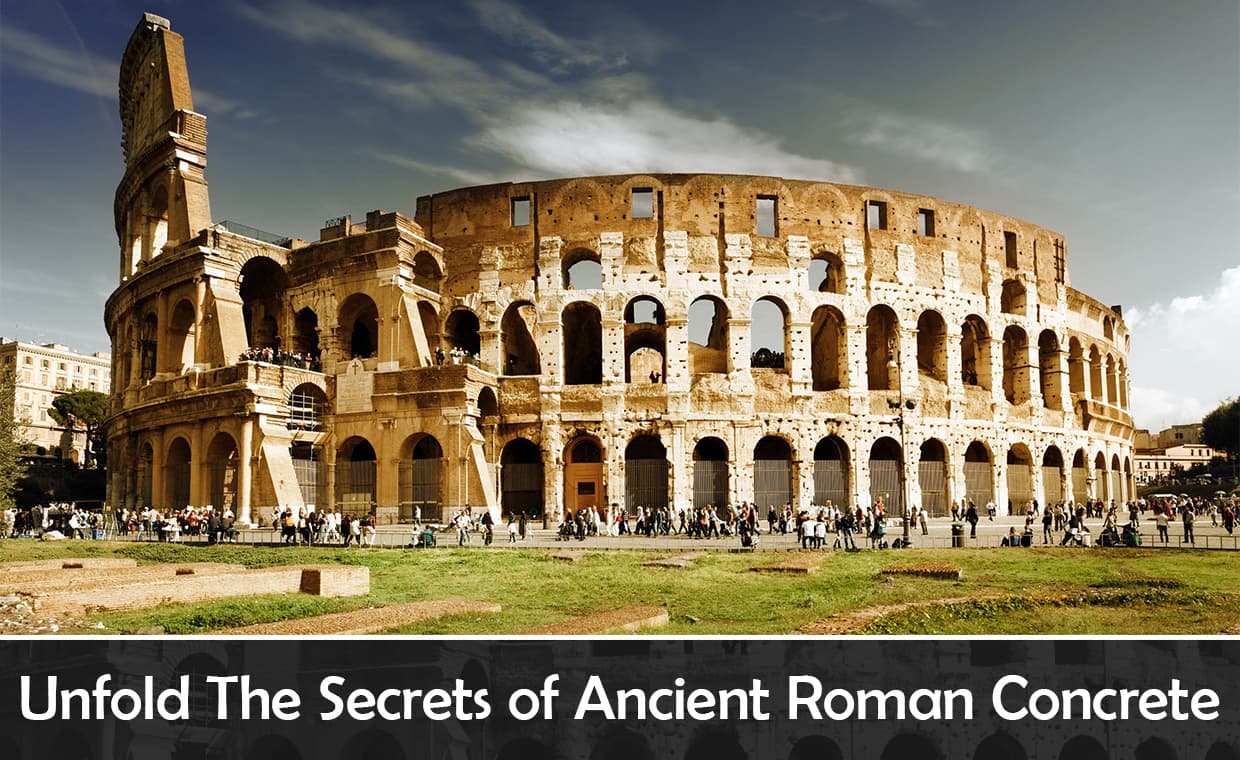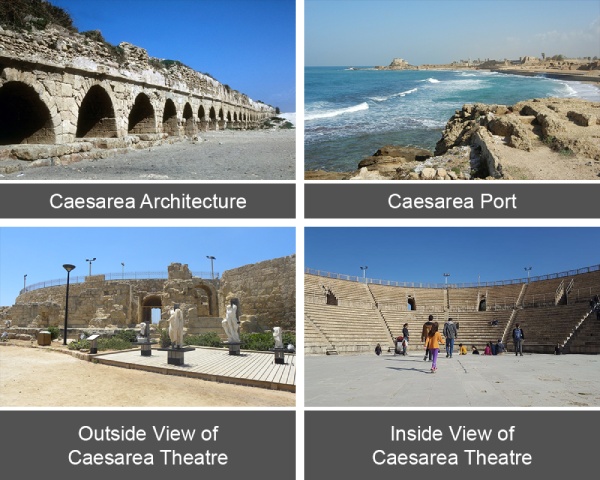
The Colosseum in Rome, Italy, is one structure that you need to visit in order to fully appreciate. The fact that this enormous structure (or most of it) has been standing for almost two thousand years is proof that the ancient Romans knew things about building construction that no one else seems to have been able to figure out since then.
And it’s not just the Colosseum. Such ancient structures can be seen throughout Rome, the most prominent of which is the Pantheon. These structures speak volumes about the strength and durability of the building materials used by the ancient Romans.
One of the key building materials used in these heavy structures is Roman concrete – a stronger, much durable ancestor than the concrete in use today.
A Brief History of Roman Concrete

Vitruvius, the ancient Roman architect, wrote extensively about Roman concrete in his books published around 25 BC. In these books, Vitruvius wrote about the appropriate aggregate proportions for preparing lime mortars.
For the structural mortars, he recommended the use of pozzuolana, a type of volcanic sand that is formed from the dried lava of erupted volcanoes. This ash-sand was brownish-yellow-grey in colour in Pozzuoli while the same material had a different, reddish-brown colour near Rome. He specified using 1:3 parts of lime and pozzuolana or 1:2 parts of lime and pozzuolana for construction underwater.
Caesarea, an ancient Roman city, has the first recorded use of underwater Roman concrete the remains of which can be still seen today.

Modern Attempts at Replicating Roman Concrete
Although there hasn’t been a successful replication of Roman concrete in recent times, there have been multiple attempts which seem promising.
Marie Jackson, a geologist and research associate professor at the University of Utah in 2017, published a paper in American Mineralogist after years of research in which she found that the biggest contributor to the strength and durability of the Roman concrete is the influence of seawater on the concrete and not the materials used in the construction.
She adds that the mineralogical structure of the concrete is strengthened by the seawater due to the growth of rare metals that reinforce the binding structure of the concrete through interlocking plates.

This is surprising since modern concrete doesn’t respond well to any kind of environmental stress, particularly seawater. This unexpected discovery shows that Roman concrete is even more resilient and effective than previously understood. The new found knowledge has led to attention from media and research communities alike.
A modern take on the Roman concrete can prove to be extremely beneficial to the construction industry, considering the many qualities it possesses.
Environmental-Friendly Nature of Roman Concrete

The production of Portland cement, the most common type of cement used around the world, is responsible for 8% of the total carbon emissions in the world, which is a huge amount. This calls for an immediate replacement of cement that’s less hostile towards the environment.
Since the Romans used pozzuolana, or volcanic ash, they didn’t need to heat limestone at 1450 degrees Celsius, which is the case with Portland cement. Thus, the amount of energy required to make Roman concrete is much less and would leave a smaller carbon footprint compared to its modern counterparts, making it the perfect replacement for modern concrete.
Green concrete and pervious concrete are also environmentally friendly options in the current scenario. If you are interested in learning more about these two kinds of concrete, you can check out our blog to get an in-depth understanding of these two topics.
Green Concrete: Its Application, Advantages & Disadvantages
Pervious Concrete – A Sustainable Choice in Construction
Apart from its longevity and strength, Roman concrete takes less time and energy for production. Additionally, a lesser amount of this cement is required during construction, thereby potentially reducing the overall costs of constructions by about 60%, which could have a huge impact on the industry.
Roman concrete is also extremely tolerant towards natural stress, which makes it create a synergy between man-made structures and the natural world.
Apart from roman concrete, we have made a comprehensive list of materials which are environment friendly building materials in this era of modernization. Click on the below article to get the list of most used eco-friendly materials to use in your own home and take a much needed steps towards sustainability.
Challenges in Recreating Roman Concrete in Modern Times

Although Roman concrete promises to effectively transform the construction industry, there are certain challenges in producing this ancient concrete. Some of the major challenges are:
Lack of Ash:
Modern attempts at recreating Roman concrete have made use of fly ash instead of pozzuolana or volcanic ash. However, there’s not enough ash in the world to replace Portland cement. That’s why, even if there’s a successful way of recreating the magic of Roman concrete, it is not possible to use it to replace modern concrete.
Long Setting Time:
The reason that Portland cement has been accepted and used widely for so many years is its extremely fast setting time. In a world where construction happens at a very fast pace, the time required for mortar to set matters and this is where Roman concrete is at a disadvantage, as it takes a very long time to set. This could hamper the construction industry and that’s why people aren’t willing to adopt it.
Transforming the World through Responsible Construction
If these challenges are overcome, Roman concrete could open a host of new opportunities and help build a stronger, more durable world. The modern Portland cement provides a building with a life span of 50-60 years, which, all things considered, isn’t a long time. Roman concrete will help us build houses, public places, and many more structures that have the ability to stand tall for thousands of years.
Moreover, the reduced carbon footprint would help make constructions eco-friendly, contributing to the worldwide attempts at reducing the impact of human societies on the natural world order. Its low cost will also make responsible construction a norm rather than a luxury; thereby completely transforming the construction industry, whose biggest concern regarding eco-friendly projects is the huge costs of constructions involved.

Similar is the story with all ancient Indian temples and places. Many temples survive even after 1000 years. The temples, architecture (sometimes as popularly called) and temple constructed even today do not use steel or any metal, cement or even bricks. It is unfortunate that the researchers and academic institution have ignored this segment in name of modernism, and calling them “traditional” or old ones.
As we continue to wait for breakthroughs in research, we ought to visit the Colosseum and other such marvels of construction, to not only get inspired, but to also understand that there’s a lot we can learn from the past. We might have advanced or evolved into smarter societies when compared to ancient civilisations, but they possessed knowledge that we no longer seem to have. If nothing else, these facts should make us humble enough to accept our short comings and look for ways to better ourselves.Let us hope that we are able to learn what we can so that we can look at not just the Colosseum, but also our own houses with pride.
We hope that we have not only cleared some of your doubts about Roman concrete, but also inspired you to learn more about ancient construction techniques. If you like our blog, then share it with your friends and spread the knowledge. Meanwhile, you can check out more articles and grow your understanding about the construction industry.
Must Read:
Plum Concrete: What | Why | Uses | Design Specifications!
Polymer Concrete: Its Pros-Cons, Uses & Properties
Bioconcrete: New Perspective of Self-Healing Concrete
Image Courtesy: Image 2, Image 4, Image 6
Author Bio
Pallavi Sen Gupta – Pallavi Sen Gupta: Knowledge increases when you share it. I could not have agreed more had I not experienced this practically as a journalist and a writer for the past 12 years. Now I dig and dive into anything I see and translate it into paper for others to know.
































